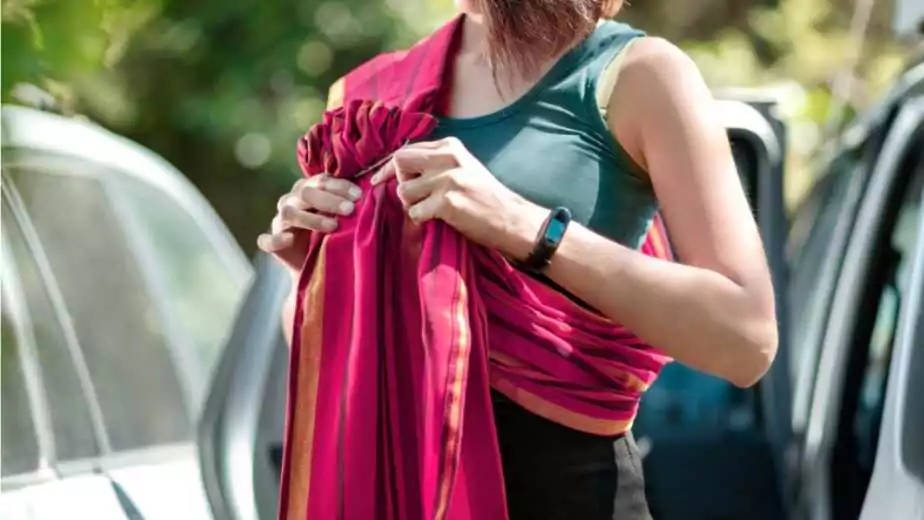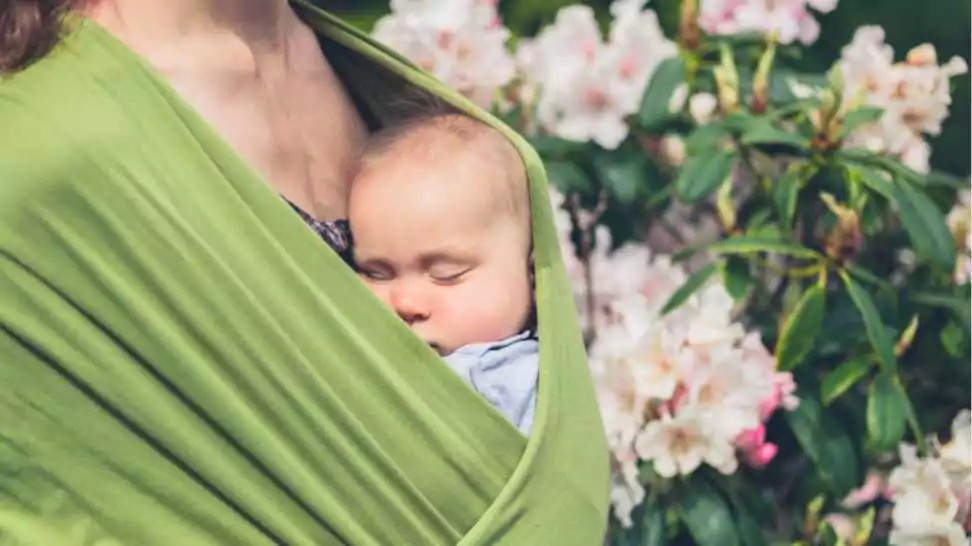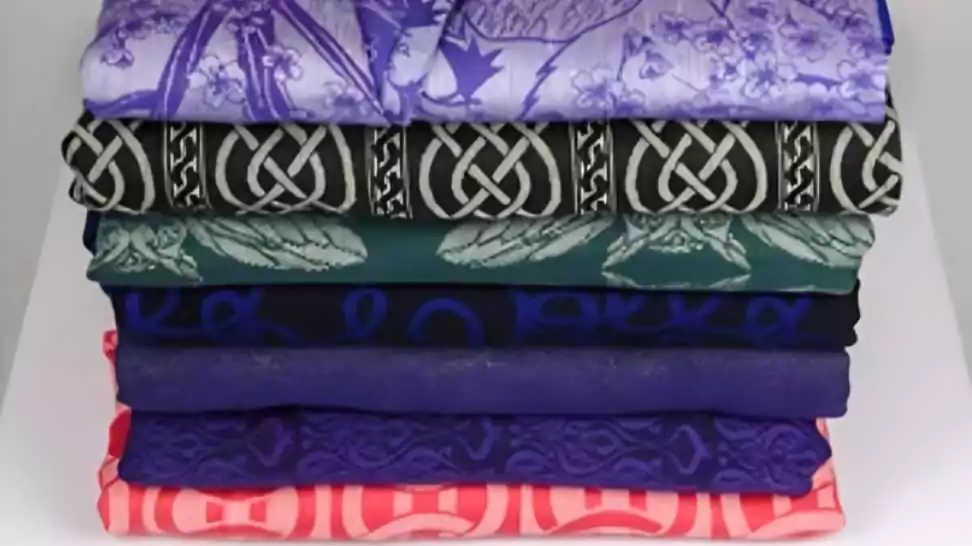How To Make A Baby Sling Easily and Safely?

The arrival of a newborn brings the dual challenges of nurturing a deep bond while juggling day-to-day responsibilities. Baby slings and pouch slings stand out as effective solutions for this, allowing parents to keep their babies close and comforted, hands-free. These carriers, deeply embedded in various cultural histories, are celebrated for their role in enhancing emotional connection and soothing infants by keeping them near the reassuring presence of a parent.
In this blog, we offer a comprehensive guide on how to make a baby sling and pouch sling. Perfect for those who love DIY projects or are searching for a unique, budget-friendly alternative to commercial options, our detailed instructions will lead you through making a carrier that is not only safe and snug but also fashionable. From choosing appropriate materials to the final stitches, we tailor our guidance to fit babies of various sizes and ages. Embark on this fulfilling endeavour with us, creating a special, handmade sling that deepens the bond with your little one.
1 Understanding Baby Slings and Pouch Slings

When it comes to babywearing, two popular options are baby slings and baby pouch slings. Though they serve a similar purpose, there are distinct differences between them in terms of design, usage, and adaptability.
What is a Baby Sling?
A baby sling is a long piece of fabric that is typically worn over one shoulder and across the torso. It forms a pouch to hold the baby snugly against the wearer’s body. The fabric usually extends from the wearer’s shoulder to the opposite hip, creating a secure and adjustable cradle for the baby. Slings are versatile and can be adjusted to accommodate different carrying positions as the baby grows.
What is a Baby Pouch Sling?

A baby pouch sling, on the other hand, is a simpler design. It is a loop of fabric, sewn into a pouch, that is worn over one shoulder like a sash. Unlike the adjustable sling, a pouch sling is sized according to the wearer and does not have rings or other adjustment mechanisms. This makes it crucial to get the right size for comfort and safety.
Advantages for Babies and Parents
Both types of slings offer a myriad of benefits for both babies and parents.
For Babies:
- Comfort and Security: Babies feel more secure when they are close to a parent’s heartbeat, warmth, and scent. This can lead to reduced crying and fussiness.
- Developmental Benefits: Being carried in a sling can stimulate cognitive development and help babies learn from their environment.
For Parents:
- Convenience: Slings allow parents to keep their babies close while keeping their hands free to perform other tasks.
- Bonding: Carrying a baby in a sling promotes bonding, as it facilitates skin-to-skin contact and interaction.
- Mobility: Slings are a more mobile and less cumbersome alternative to strollers, especially in crowded or narrow spaces.
2 Choosing the Right Materials
Before you start crafting your baby sling or pouch sling, it’s crucial to select the right materials. The choice of fabric and additional components can significantly impact the safety, comfort, and durability of your sling.
Materials Needed for Both Types of Slings
- Fabric: The amount of fabric you need will depend on the type of sling and the size of the wearer and the baby. Generally, for a baby sling, you’ll need about 2 to 2.5 yards of fabric, while a pouch sling may require slightly less.
- Rings (for Baby Sling): If you’re making an adjustable sling, you’ll need a pair of strong, non-welded metal rings. These should be specifically designed for baby slings, usually made of aluminium or nylon.
- Thread: Use a high-quality, strong thread suitable for sewing the chosen fabric.
- Sewing Essentials: Basic sewing supplies like scissors, measuring tape, pins, and a sewing machine (or a needle for hand sewing).
Selecting the Right Fabric

The fabric is the most crucial element in a baby sling or pouch sling. Here are some tips to help you choose the best fabric:
- Safety First: Opt for strong, durable fabrics that can support the baby’s weight without tearing. Avoid stretchy fabrics for the main body of the sling, as they can sag under the baby’s weight, making it unsafe.
- Comfort: Choose a fabric that is soft and gentle against the baby’s skin. Natural fibres like cotton, linen, or bamboo blends are excellent choices. They are breathable, which is essential to prevent overheating.
- Durability: Consider fabrics that can withstand frequent washing and wear. The material should be colourfast and able to maintain its strength over time.
- Seasonal Considerations: For summer use, lightweight and breathable fabrics are ideal. In contrast, for colder months, you might want a slightly heavier fabric to provide extra warmth.
- Aesthetic Appeal: While functionality is paramount, you may also want to choose a fabric that matches your style. There’s a wide range of colours and patterns available, so you can select something that you’ll love to wear.
3 Preparing to Make Your Baby Sling

Now that you have chosen the right materials, it’s time to start making your baby sling. This section will guide you through the process of measuring, cutting, hemming, and adding features to your sling.
Step 1: Measuring and Cutting the Fabric
- Measure: If you’re average height, start with 2 yards of fabric. If you’re taller or plus-sized, consider 2.5 yards. The fabric should be at least 22 inches wide for adequate support.
- Cut: Lay the fabric flat and trim any uneven edges. For a tapered end, fold the fabric in half lengthwise and cut at a slight angle towards the fold, starting about 10 inches from the end.
Step 2: Hemming and Finishing the Edges
- Hem: Fold the edges of the fabric (about 1/4 to 1/2 inch) and iron flat to create a clean line.
- Sew: Using your sewing machine (or hand-sew if you prefer), stitch the hem all around the fabric. Be sure to reinforce the stitching at the tapered ends for added strength.
Step 3: Adding Adjustable Rings (Optional)
- Attach Rings: If you’re making an adjustable sling, fold the tapered end of the sling over the rings and sew it down to create a secure pouch for the rings.
- Reinforce: Ensure the area around the rings is well-reinforced with multiple stitches to bear the weight of the baby.
Step 4: Adding Additional Features (Optional)
- Pockets: You can sew a pocket on the sling’s tail for convenience.
- Padding: For extra comfort, especially around the shoulder, you can add padding. Just sew a thin layer of cushioning into the shoulder area.
Creating your baby sling can be a fulfilling DIY project. Not only does it save you money, but it also allows you to add a personal touch to something you and your baby will use daily. In the next section, we will cover the steps to make a baby pouch sling.
4 Crafting Your Baby Pouch Sling
After mastering the baby sling, you might want to try your hand at making a baby pouch sling. This type of sling is simpler in design but requires precise measurement for a snug and safe fit.
Step 1: Calculating Size and Cutting the Fabric
- Measure: To determine the length of your pouch sling, measure from your shoulder to the opposite hip and then back to the shoulder. Add a few inches for seam allowance.
- Cut: Based on your measurement, cut a length of fabric. The width should be about 20 to 22 inches for adequate support.
Step 2: Sewing the Sling
- Fold: Fold the fabric in half lengthwise with the right sides facing each other.
- Sew: Stitch along the long edge, leaving about a 1/2-inch seam allowance. Turn the tube you’ve created right side out.
- Curved Seam: Sew a curved seam at each end of the tube to create the pouch shape. This curve should be deeper for a snugger fit.
Step 3: Safety Checks and Adjustments
- Check the Fit: Before using the sling, ensure it fits snugly but comfortably. The baby should sit at your waist level when placed in the sling.
- Adjustments: If the sling is too loose, you may need to take in more fabric at the seams. Ensure the adjustments are even on both sides for balance.
5 Safety Tips and Best Practices
General Safety Guidelines
- Check Regularly: Always inspect your homemade sling for any wear and tear before use.
- Secure Fit: Ensure the sling fits snugly. The baby should not be too low in the sling, as this can pose a risk to their safety.
- Comfort: Adjust the sling so that it’s comfortable for both you and your baby, without any undue pressure on your back or shoulders.
Dos and Don'ts
Do:
- Use sturdy, non-stretchy fabric for your sling.
- Ensure the baby’s face is always visible and not pressed against the fabric or your body.
- Keep the baby’s chin off their chest to maintain a clear airway.
Don’t:
- Use a sling that is too big or too small.
- Bend at the waist without supporting the baby with one hand.
- Cover the baby’s face with the sling fabric.
Ensuring Safe Baby Positioning

- Airway Safety: The baby’s airway should always be clear. Their head should be at or above the rim of the sling, and their face should be visible at all times.
- Correct Position: The recommended position is upright, with the baby’s back straight and supported. For newborns and small infants, the ‘froggy’ position, where the baby’s knees are higher than their bottom, is ideal.
- Monitor: Regularly check on the baby, especially if they fall asleep in the sling. Their position should allow for easy breathing at all times.
6 Customising Your Sling and Pouch
Creating your own baby sling or pouch sling offers the unique opportunity to personalise this essential parenting tool. Here are some ideas for customisation and tips for maintaining your sling to ensure its longevity and safety.
Personalisation Ideas
- Fabric Choices: Choose fabrics that reflect your style. Consider seasonal patterns, bold colours, or even themed prints that resonate with your interests.
- Decorations: Add a touch of flair with decorations like embroidery, fabric paint, or iron-on patches. Ensure any decorations are securely attached and won’t pose a choking hazard.
- Contrasting Borders: For an added visual appeal, use a contrasting fabric colour or pattern for the borders.
- Adjustable Features: Incorporate adjustable rings or straps for added convenience and flexibility.
- Pockets: Sew in a small pocket for essentials like keys, a pacifier, or your phone.
Maintenance Tips
- Regular Inspection: Check the sling regularly for any signs of wear and tear, especially around seams and rings.
- Washing: Follow fabric care instructions. Most slings can be machine-washed in a gentle cycle and air-dried to prevent shrinking.
- Storage: Store the sling in a dry place when not in use. Avoid storing it in direct sunlight, which can fade the fabric and weaken fibres over time.
- Repairs: Address any damage immediately. Small rips or loose threads can quickly turn into larger safety issues.
Safety with Customisation

Remember, while customising your sling or pouch, always prioritise safety over aesthetics. Avoid heavy or dangling accessories, and ensure any added element does not interfere with the sling’s functionality or the baby’s comfort and safety.
7 Wrapping Up
In this guide, we’ve journeyed through the essentials of baby slings and pouch slings, from understanding their benefits to mastering the art of making them. We’ve emphasised the importance of choosing safe, comfortable, and durable materials and provided clear, step-by-step instructions for crafting your own. Alongside these practical tips, we’ve underscored critical safety practices and encouraged personalising your creations to reflect your style.
Now, it’s your turn to embark on this rewarding DIY adventure, strengthening the bond with your baby uniquely and creatively. We’re eager to hear about your experiences and see how you’ve added your personal touch to your slings. Your stories and feedback are not just valuable to us but also other parents on a similar journey.
Thank you for joining us in this guide. We wish you joy in your baby-wearing and DIY endeavours!
Community Q&A
About This Article
This article has been viewed 109 times.



